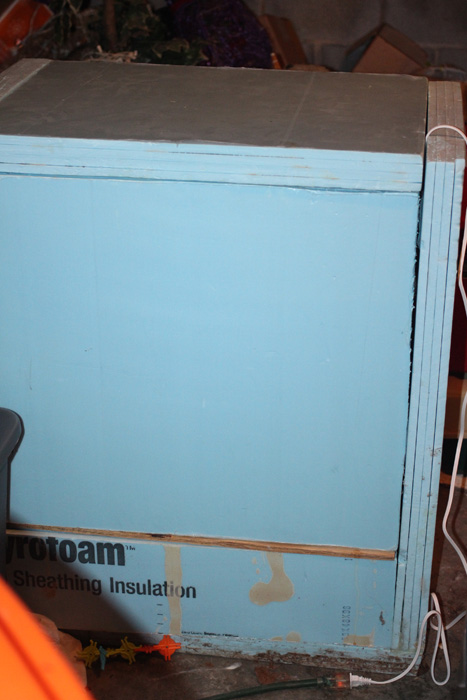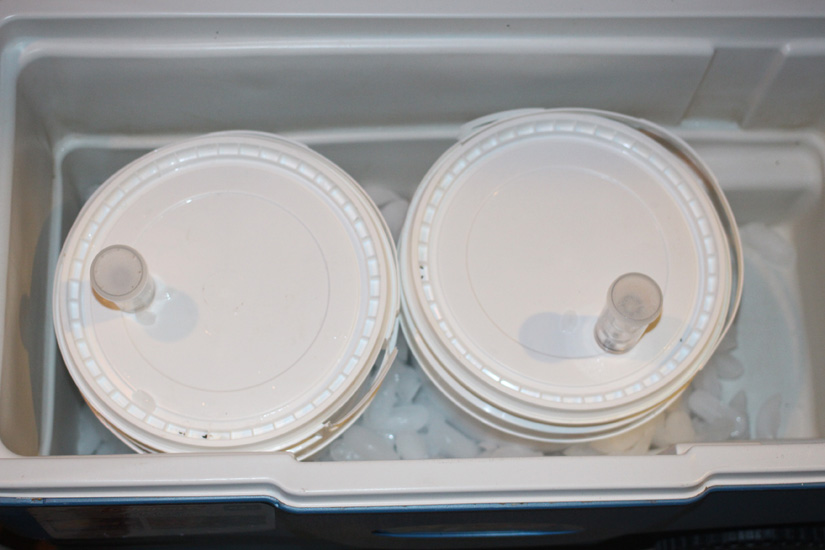A Low Tech Solution to Cold Crashing
As you may know, I currently have a split batch of competition beer going. Four gallons have been hit with WLP820 to become a Festbier, and are located in a carboy inside my fermentation chamber (an ancient mini fridge with an STC-1000 temperature controller). I love the control that this setup gives me; set the desired temperature, then walk away in confidence that my beer will remain within one degree F of my target temperature.
On the other hand, I have about three other gallons with WLP500, which are then further split between a pair of two gallon buckets; these will become variations on a Belgian Blond. These two gallons have been sitting in my DIY Son of a Fermentation Chamber, which has been brought out of semi-retirement to serve as my backup fermentation chamber. While the SOAFC is a great improvement over absence of temperature control, it is nowhere near as precise as my fridge/STC-1000 combo; luckily, I had planned to keep this Belgian yeast happy with a little heat, anyway.

Some high tech gear, here.
Since these are competition beers, my desire for clarity extends beyond vanity. I had planned to cold crash and treat both beers with gelatin, then complete the "fast lager" process on the Festbier. Cold crashing is obviously a simple thing in a mini fridge, but I was drawing a blank as to how I would pull the task off in my SOAFC. I considered frozen two liter bottles of water, perhaps wrap the buckets with ice under blankets inside of the chamber... but really, it didn't seem like a likely solution. Perhaps I was wasting my time...
It was then then my gaze fell upon my mash tun - a converted 62 quart Coleman xTreme cooler. The thing holds heat really well, and everyone knows that coolers do a better job holding cold temps than hot ones; I mean, it is what they are designed for, after all. So, on a lark, I grabbed one of the buckets - and lo and behold, it fit! In fact, both buckets fit well within the cooler, leaving just enough vertical clearance to close the lid.
Next up was a quick trip upstairs to grab the icemaker drawer from the freezer. I dumped the full contents of this into the ice chest, and added a couple of 20 ounce bottles of frozen water for good measure. Sure enough, most of the ice was still intact the following morning, so I mixed up a little gelatin, heated it in the microwave, and added it to the buckets. When I got home from work that night. I discovered that I still had a few ice shards left, plus some nice ice cores in the 20 ounce bottles.

Ice, ice, baby!
In other words, this is a near perfect setup for cold crashing these little buckets. I'll add ice once per day, and the beer will stay nice and cold until bottling time. With any luck, I really will end up with some nice, clear beer.
One footnote for those waiting for the typical "Homebrew Dad screwup"... I won't disappoint you.
The night after my amazing discovery, my wife made a passing comment, wondering about why there were so many ice cubs scattered around the interior of the freezer. "I can explain that one," I offered sheepishly.
My polite, demure wife fixed me with an expression somewhere between bemusement and exasperation. "Okay, dumbass," she sweetly implored, "what did you manage to do this time?"
Sheesh.
I explained that I may have gotten distracted with how well my idea had worked, and it was entirely possible that I had set the icemaker drawer down in the basement, then forgotten about it until the next morning. Of course, the freezer continued to make ice all night long, thus scattering cubes all through the freezer.
Whoops.
Permalink
Tags for this post: cold, crash, fermentation, chamber, ice, cooler, festbier, Belgian, blond
1 Comments
Thanks for posting. Im wondering how you approach cold crash suckback / air pressure drop as the temperature drops.
You still have the airlocks on in the image. Do you pop a bung in? or let the O2 in?
posted by lizzard on 8/21/2015 at 07:10:19 PM
On the other hand, I have about three other gallons with WLP500, which are then further split between a pair of two gallon buckets; these will become variations on a Belgian Blond. These two gallons have been sitting in my DIY Son of a Fermentation Chamber, which has been brought out of semi-retirement to serve as my backup fermentation chamber. While the SOAFC is a great improvement over absence of temperature control, it is nowhere near as precise as my fridge/STC-1000 combo; luckily, I had planned to keep this Belgian yeast happy with a little heat, anyway.

Some high tech gear, here.
Since these are competition beers, my desire for clarity extends beyond vanity. I had planned to cold crash and treat both beers with gelatin, then complete the "fast lager" process on the Festbier. Cold crashing is obviously a simple thing in a mini fridge, but I was drawing a blank as to how I would pull the task off in my SOAFC. I considered frozen two liter bottles of water, perhaps wrap the buckets with ice under blankets inside of the chamber... but really, it didn't seem like a likely solution. Perhaps I was wasting my time...
It was then then my gaze fell upon my mash tun - a converted 62 quart Coleman xTreme cooler. The thing holds heat really well, and everyone knows that coolers do a better job holding cold temps than hot ones; I mean, it is what they are designed for, after all. So, on a lark, I grabbed one of the buckets - and lo and behold, it fit! In fact, both buckets fit well within the cooler, leaving just enough vertical clearance to close the lid.
Next up was a quick trip upstairs to grab the icemaker drawer from the freezer. I dumped the full contents of this into the ice chest, and added a couple of 20 ounce bottles of frozen water for good measure. Sure enough, most of the ice was still intact the following morning, so I mixed up a little gelatin, heated it in the microwave, and added it to the buckets. When I got home from work that night. I discovered that I still had a few ice shards left, plus some nice ice cores in the 20 ounce bottles.

Ice, ice, baby!
In other words, this is a near perfect setup for cold crashing these little buckets. I'll add ice once per day, and the beer will stay nice and cold until bottling time. With any luck, I really will end up with some nice, clear beer.
One footnote for those waiting for the typical "Homebrew Dad screwup"... I won't disappoint you.
The night after my amazing discovery, my wife made a passing comment, wondering about why there were so many ice cubs scattered around the interior of the freezer. "I can explain that one," I offered sheepishly.
My polite, demure wife fixed me with an expression somewhere between bemusement and exasperation. "Okay, dumbass," she sweetly implored, "what did you manage to do this time?"
Sheesh.
I explained that I may have gotten distracted with how well my idea had worked, and it was entirely possible that I had set the icemaker drawer down in the basement, then forgotten about it until the next morning. Of course, the freezer continued to make ice all night long, thus scattering cubes all through the freezer.
Whoops.
Permalink
Tags for this post: cold, crash, fermentation, chamber, ice, cooler, festbier, Belgian, blond






Please support BrewUnited by using our Amazon affiliate link when doing any shopping there - be it for homebrewing or for your regular shopping!
1 Comments
Thanks for posting. Im wondering how you approach cold crash suckback / air pressure drop as the temperature drops.
You still have the airlocks on in the image. Do you pop a bung in? or let the O2 in?
posted by lizzard on 8/21/2015 at 07:10:19 PM

